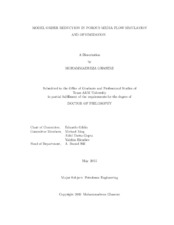| dc.description.abstract | Subsurface flow modeling and simulation is ubiquitous in many energy related processes, including oil and gas production. These models are usually large scale and simulating them can be very computationally demanding, particularly in work-flows that require hundreds, if not thousands, runs of a model to achieve the optimal production solution. The primary objective of this study is to reduce the complexity of reservoir simulation, and to accelerate production optimization via model order reduction (MOR) by proposing two novel strategies, Proper Orthogonal Decomposition with Discrete Empirical Interpolation Method (POD-DEIM), and Quadratic Bilinear Formulation (QBLF). While the former is a training-based approach whereby one runs several reservoir models for different input strategies before reducing the model, the latter is a training-free approach.
Model order reduction by POD has been shown to be a viable way to reduce the computational cost of flow simulation. However, in the case of porous media flow models, this type of MOR scheme does not immediately yield a computationally efficient reduced system. The main difficulty arises in evaluating nonlinear terms on a reduced subspace. One way to overcome this difficulty is to apply DEIM onto the nonlinear functions (fractional flow, for instance) and to select a small set of grid blocks based on a greedy algorithm. The nonlinear terms are evaluated at these few grid blocks and interpolation based on projection is used for the rest of them. Furthermore, to reduce the number of POD-DEIM basis and the error, a new approach is integrated in this study to update the basis online. In the regular POD-DEIM work flow all the snapshots are used to find one single reduced subspace, whereas in the new technique, namely the localized POD-DEIM, the snapshots are clustered into different groups by means of clustering techniques (k-means), and the reduced subspaces are computed for each cluster in the online (pre-processing) phase.
In the online phase, at each time step, the reduced states are used in a classifier to find the most representative basis and to update the reduced subspace. In the second approach in order to overcome the issue of nonlinearity, the QBLF of the original nonlinear porous media flow system is introduced, yielding a system that is linear in the input and linear in the state, but not in both input and state jointly. Primarily, a new set of variables is used to change the problem into QBLF. To highlight the superiority of this approach, the new formulation is compared with a Taylor's series expansion of the system. At this initial phase of development, a POD-based model reduction is integrated with the QBLF in this study in order to reduce the computational costs. This new reduced model has the same form as the original high fidelity model and thus preserves the properties such as stability and passivity. This new form also facilitates the investigation of systematic MOR, where no training or snapshot is required.
We test these MOR algorithms on the SPE10 and the results suggest twofold runtime speedups for a case study with more than 60,000 grid blocks. In the case of the QBLF, the results suggests moderate speedups, but more investigation is needed to accommodate an efficient implementation. Finally, MOR is integrated in the optimization work flow for accelerating it. The gradient based optimization framework is used due to its efficiency and fast convergence. This work flow is modified to include the reduced order model and consequently to reduce the computational cost. The water flooding optimization is applied to an offshore reservoir benchmark model, UNISIM-I-D, which has around 38,000 active grid blocks and 25 wells. The numerical solutions demonstrate that the POD-based model order reduction can reproduce accurate optimization results while providing reasonable speedups. | en |


